21 best outdoor games to play
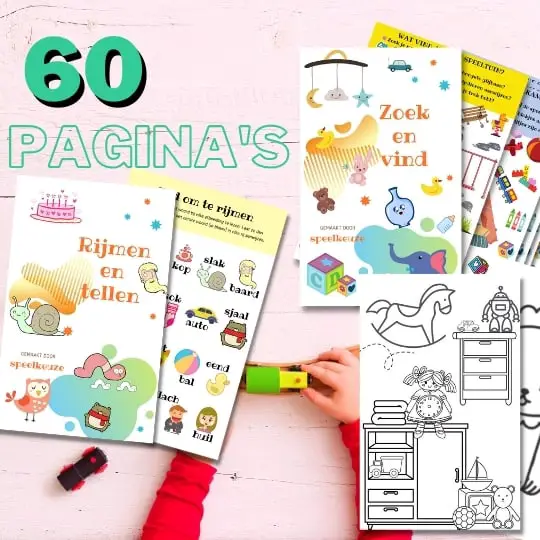
Always something to do for the holidays or rainy day?
Play Choice now has the ultimate activity book collection, with over 60 pages of fun coloring pages and educational puzzles.
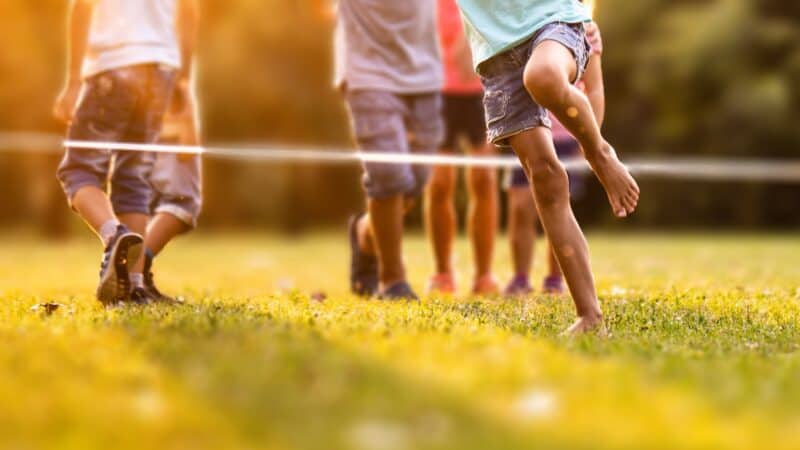
If they like playing outside but aren't sure what to do, here are a lot of fun games to play.
Playing outside is no longer as popular as it used to be. Playgrounds are increasingly deserted because children prefer to play indoors.
The reason? Children are consumed by screens. Videos and games are therefore very addictive. But playing outside has a lot of benefits for the development of children.
For example, it stimulates creativity, ensures a healthy immune system and is good for vitamin D.
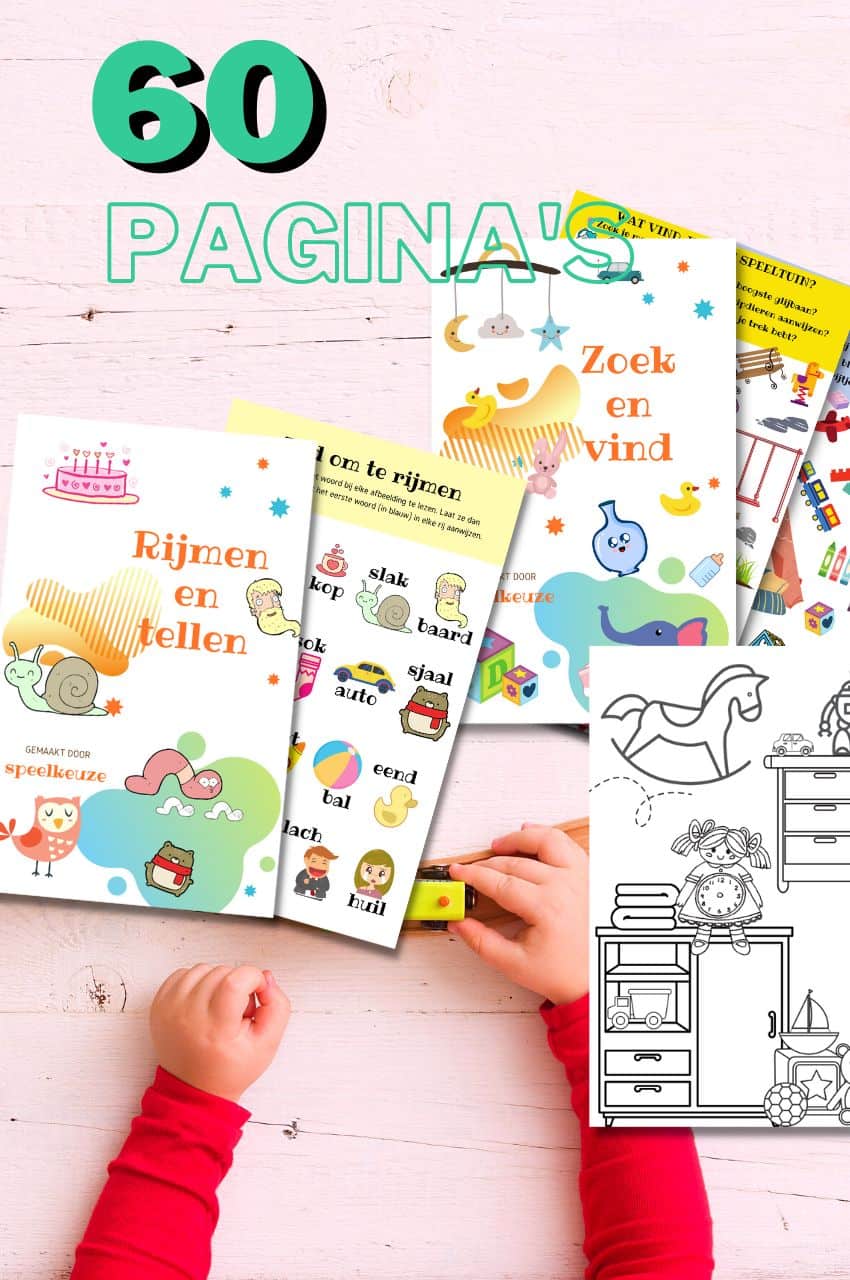
From toddler to toddler activity book collection
Educational games and coloring pages for 3 to 6 years
Your toddler and preschooler will love this e-book, along with the accompanying printables. He or she can play with it at every stage of development, together with mom and dad.
Buy at Bol.comWhat we discuss in this comprehensive post:
- 1 Top 21 best outdoor games
- 1.1 Hide and seek
- 1.2 Kick the can
- 1.3 Capture the flag
- 1.4 Four squares (Foursquare)
- 1.5 Hopscotch
- 1.6 Jumping rope
- 1.7 Marbles
- 1.8 Playing tag
- 1.9 Best rated for outdoor play together: Spikeball 3 ball set
- 1.10 bean bag toss
- 1.11 Best offside for grass: Mölkky Finnish throwing game
- 1.12 Best for smaller children: ring throwing dancing worm
- 1.13 Best Yahtzee Outdoor Game: BS Toys
- 1.14 Best for the two of you: four in a row great for outside
- 1.15 Best Garden Jenga: Giantville Tumbling Timber
- 1.16 Can Jam Ultimate Disc Game
- 1.17 Best boules set: Get & Go
- 1.18 Best outdoor game for the pool: Atomic vortex
- 1.19 Jumping on the trampoline
- 1.20 Skateboarding
- 1.21 Beach volleyball
- 2 Why do children play outside less?
- 3 What are the benefits of playing outside?
- 4 How do you encourage children to play outside?
- 5 When are outdoor games the most fun to do with the family?
Top 21 best outdoor games
Hide and seek
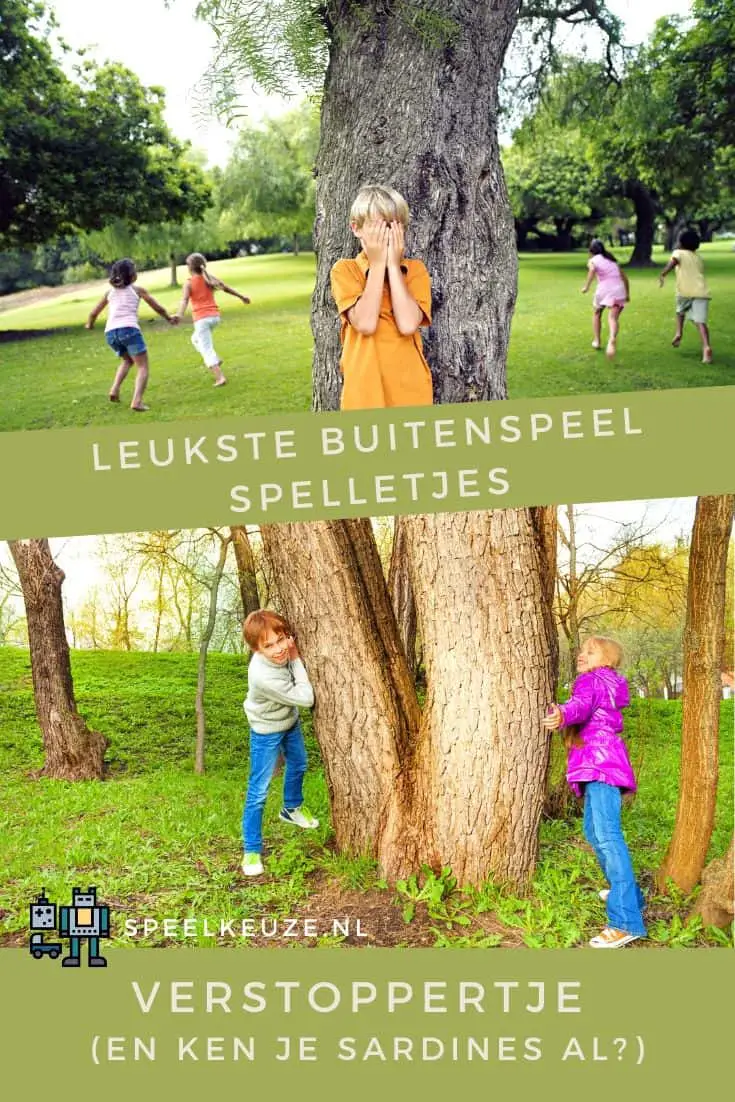
Everyone has played this, so a nice classic to give to your children.
Most parents have played with their children, because hiding and finding again serves an educational interest in small children.
I've heard of all kinds of variations on this game.
- Sometimes you count to twenty
- sometimes ten,
- sometimes up to a hundred if you have a large playground or schoolyard.
- Sometimes there is a home base that you can run to without getting tagged, making you 'safe',
- sometimes you just wait, hidden, to be found.
- Another very nice variant is sardines, where just one child is hiding and the rest has to find him or her. If someone found it, he should hide by it. Then the next child who finds the group, etc. until only one child remains to find the “sardines that are stuffed in a can”.
The general idea is that one person is 'it', that person closes his or her eyes and counts to a certain number without looking and then he or she tries to find the others.
- Number of players: ideally at least three
- Supplies: no
Kick the can

This game is a variation of tag and hide and seek.
- One person or a team of children is identified as “the” and a can is placed in the center of the playing area.
- The other kids run and hide while the “it” covers his or her eyes and counts to a certain number.
- “It” then tries to find everyone.
- If a person is tagged by "it", they go into a place for trapped players.
- If one of the non-captured players manages to kick the can, the captured players are released.
The game ends when all not-it-players are in prison.
- Number of players: ideally at least three
- Supplies: um… a can
Capture the flag

This game is best when you play with a large group.
- Divide the group into two teams, each team has a flag or other marker in the base of the team (or on one side of a field).
- The object of the game is to run into the other team's territory, capture their flag and return safely to your own territory.
- You can tap “enemy” players into your territory and send them to your prison.
- They can be taken out of prison by a member of their own team who walks into your territory, taps a teammate and then runs back (nicest thing to allow only one kid out of prison at a time. It is sometimes played that all people in prison holding hands and making a chain back to their own territory, making it easier for members of their team to get them out of prison).
There is also a similar game called “steal the sticks” with almost the same rules, but now multiple sticks are used instead of one flag and you have to collect them all without being tapped.
- Number of players: a large group
- Supplies: two flags or other markings
Four squares (Foursquare)
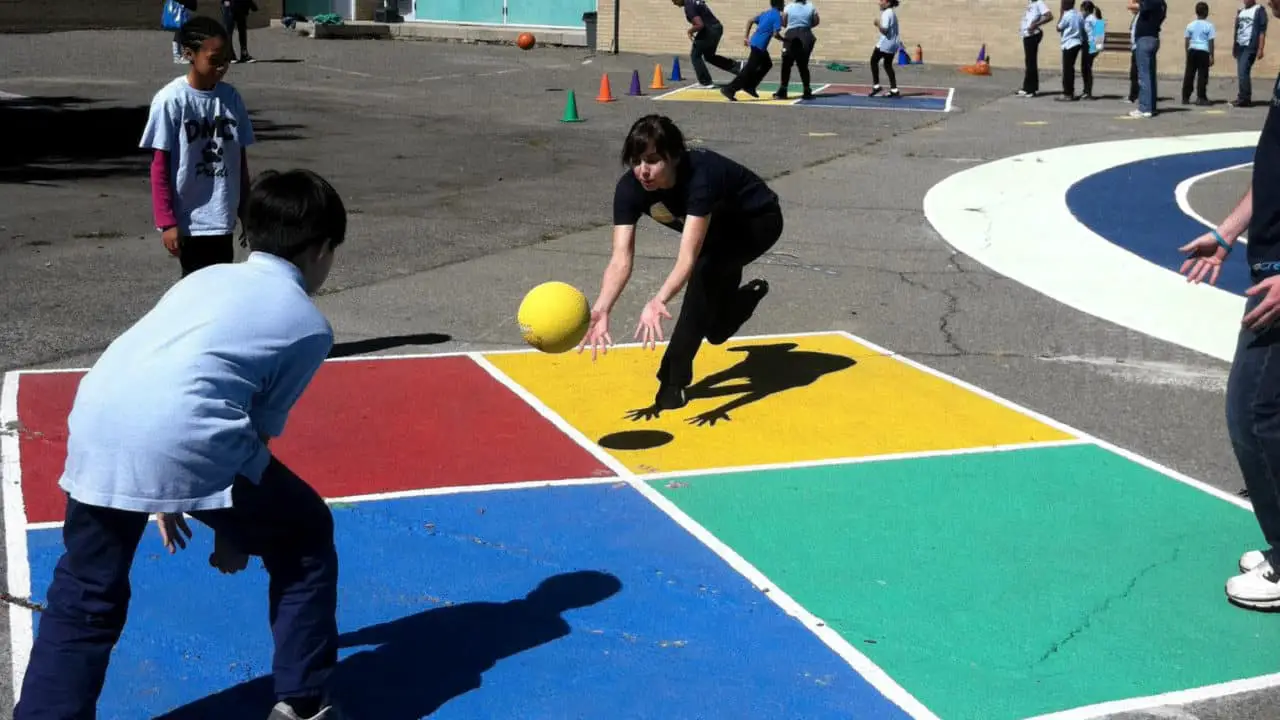
(photo: playworks.org)
This ball game is played on a square field that is further divided into four smaller squares, numbered one through four.
- Each of the squares has one player, with the player with the most points at number one, lowest at number four.
- You bounce the ball between the players and bounce once on the other person's court before that person catches the ball.
There are tons of additional rules to choose from. The person in square 1 may choose the rules (limping, starting outside the box, can be anything).
Anyone who breaks the rules must go down the rankings or be eliminated with another player turning to square four if you have more than four players.
- Number of players: Four, unless you take turns
- Supplies: sidewalk chalk for the course, and a cue ball
Hopscotch
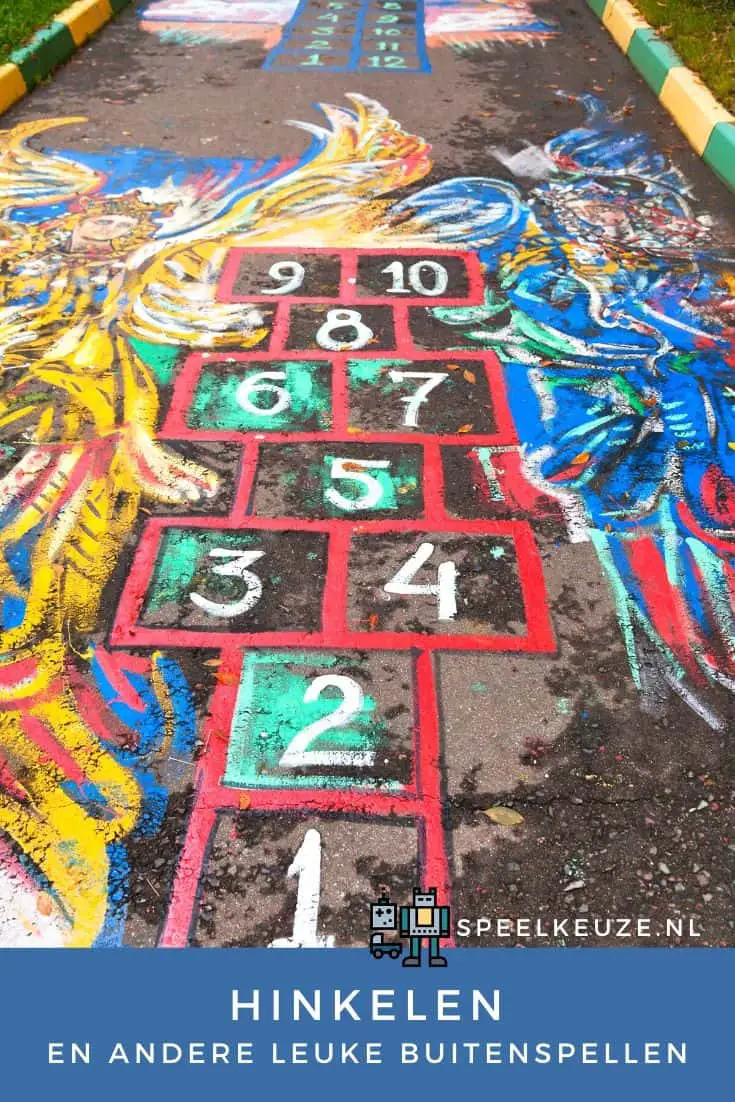
Use some sidewalk chalk and make the nicest hopscotch you can. Number the squares from one to nine or ten. Choose a rock that is good to throw.
Small stones can bounce too much and larger ones are difficult to throw.
- Start by throwing the stone on square 1.
- Jump over the stone and jump with a single foot or both feet (to follow the hopscotch pattern, a single square is on one foot, two squares next to each other is both feet each in one of the squares) all the way to the end.
- Turn around and come back, stop on square 2.
- Balancing on one foot, pick up the stone in box 1 and jump over box 1 to the start.
- Continue this pattern with square 2 and so on, skipping the square with the stone each time.
- If you throw your stone and miss the correct square, your turn is over.
This game can be played with an unlimited number of people, but only one person can take a turn at a time.
If it's raining or dark or too cold, you can hopscotch mats or pieces of foam like these for indoor purchase:
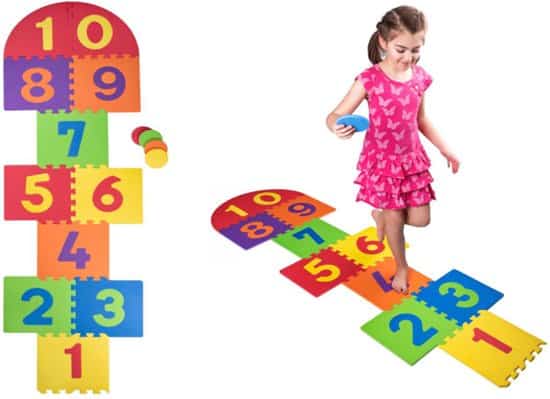
Or if it is extremely hot this water hopscotch mat a nice one for the garden:
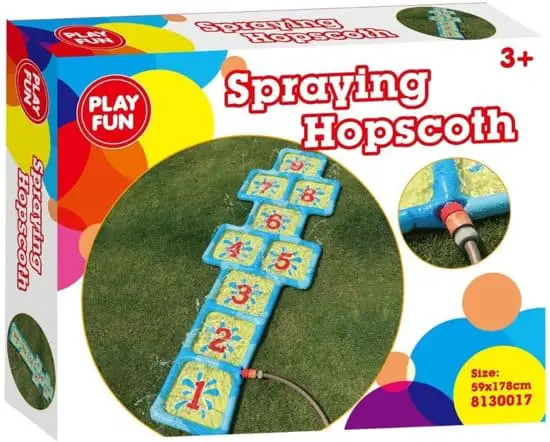
- Number of players: one by one, as much as you want
- Supplies: sidewalk chalk or hopscotch and a stone
Jumping rope
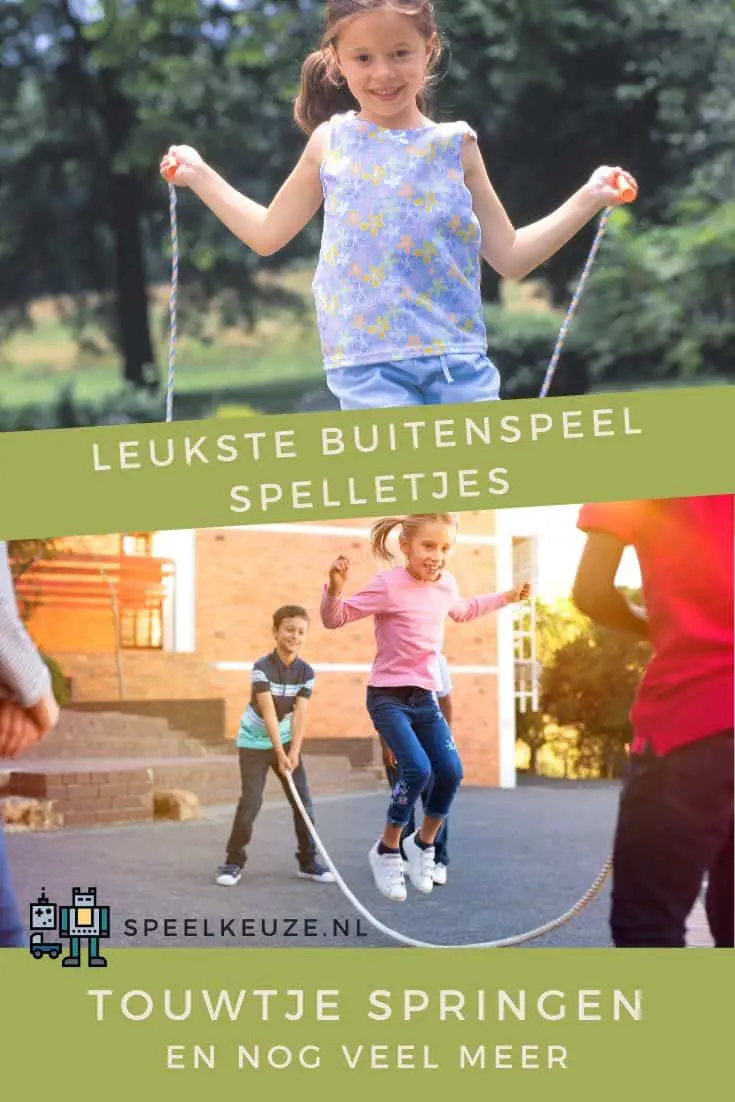
One of the greatest ways in which many children spend their break was and still is skipping rope.
It's fun to jump alone, but it's even more fun to have a long rope and jump with some friends.
That's where jump rope rhymes come into being. They turn a simple exercise into a fun game of competing against yourself and others.
- Number of players: One for single jumping, minimum three for a longer rope
- Supplies: a short or long skipping rope
Marbles
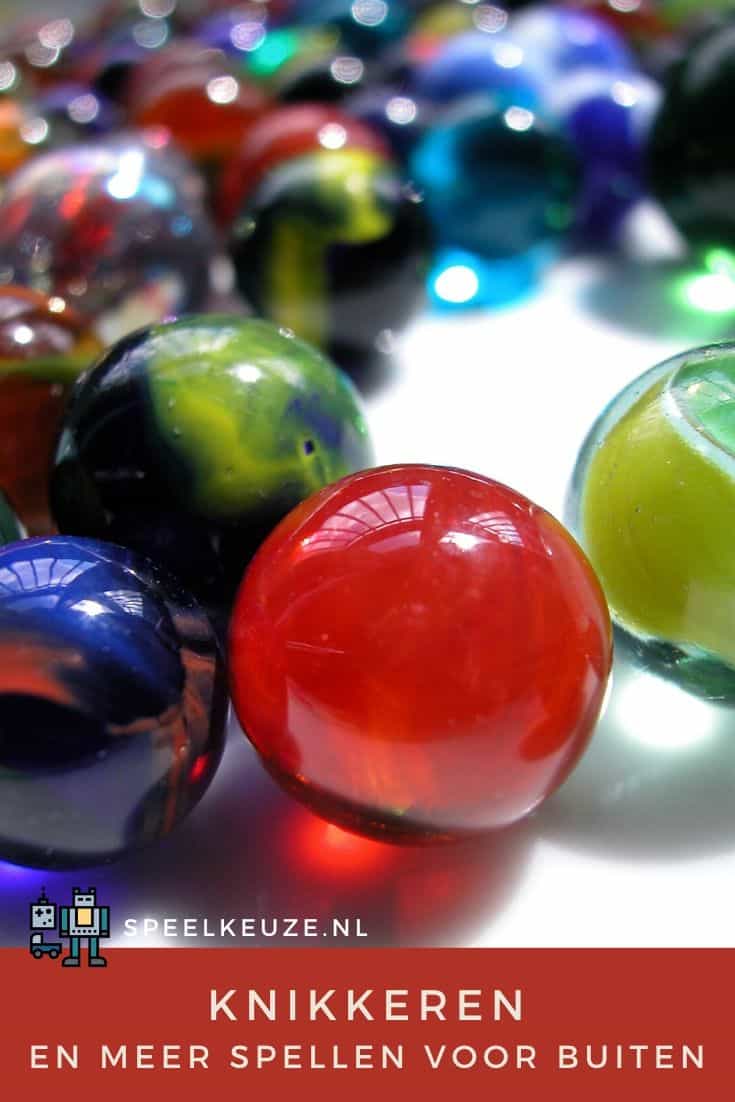
The general rules are that you must bounce the other person away with your marbles.
As with the other games, there are numerous variations.
- that you make a circle in the sand (more fun sand games here) or draw on the sidewalk and then take turns trying to bounce each other's marbles out of the circle with your own large marble.
- that you have a well as is the case with many schoolyards, but you also have them as tiles for your garden, and that you take turns to get your marbles in first.
- my favorite was always that the well was close to the wall and that you could only bounce through the wall.

- Number of players: at least two but as much as you want
- Supplies: marbles, possibly chalk to draw a circle or a well
Playing tag

It seems like everyone knows how to play tag, but in case your childhood has faded a bit, here's exactly how to play:
- A group of children decides who will start as “it”. That person chases the other kids and tries to tap one of them with their hand.
- The newly typed person is now “it”.
There is often the rule “no double tap” whereby you cannot immediately tap back the person who just tapped you.
4 fun variations of tag:
- shadow tag: In this fun version of tag, tap each other's shadows with your feet instead of tapping their bodies. So it should be played on a sunny day. The closer to noon, the greater the difficulty (due to the position of the sun).
- to freeze: This is a variation of tag where if the person who “it” is tapping you, you have to freeze where you are. Another player can tap you again to defrost you.
- TV tag: A variation of freeze is TV tag, where the person who wants to unfreeze the frozen player must shout out the title of a TV show. That program may no longer be used during the game. If someone calls a program that has already been said, he must freeze himself.
- blind man: This game is yet another variation of tag. The person who “it” is wearing a blindfold and trying to tap the other players. Those others have to keep calling to let them know where they are. Make sure to play this in an area that is protected from obstacles and other hazards.
The game is over when everyone gets tired of playing.
- Number of players: a nice large group
- Supplies: no.
Best rated for outdoor play together: Spikeball 3 ball set
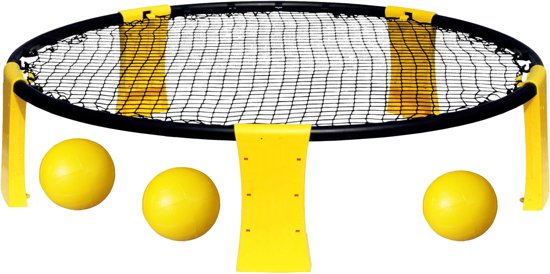
If they themselves would not go out so quickly but are always up for a fun game to play, these are the best games to give them.
“Spikeball is one of the best garden games ever invented,” says one reviewer, explaining the reasons.
"It's easy to carry, easy to set up, and it's an easy game that anyone can pick up quickly."
“Fun” is a word used in hundreds of reviews, and the general consensus is that this is a game for all ages.
“We've played from 5 to 65 years ... even a pregnant mother,” writes one reviewer.
As one reviewer puts it:
“It's essentially volleyball, but instead of the ball going over the net, you have to hit the net. As soon as he hits the net, the other team takes over. ”
That's why several reviewers say it's a great form of cardio.
Many also like how easy it is to take this game with you wherever you go.
"We really enjoy playing this game in the grass, on the beach, camping and more," said one reviewer, adding:
“You need a fairly large, open space to play, but everything can be assembled and disassembled easily and quickly, making it easy to transport! ”
bean bag toss
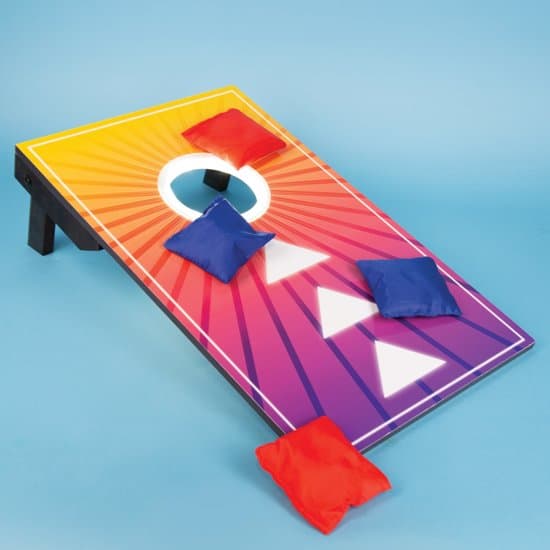
This Fizz Light up pocket throw set is what I would classify as the Cadillac of corn board planks, ”writes one reviewer.
Quality is a word that comes up in dozens of reviews, and many also like that these folding shelves are easy to transport.
“I've played on a lot of different sets in my time and I have to say, this one is really, really fun,” writes one reviewer.
"The portability is great, it's not too light (you don't want the shelves to shift evenly when you throw a bag at them) but they aren't too heavy to lug around long distances."
While many reviews mention the convenience of taking this game to the beach or on a camping trip, this bean bag set is also light enough to make the trip to “Aruba and Mexico,” said one reviewer.
Wherever you end up going, one reviewer says you can play for a long time. “The planks and bags also withstand intense play,” they write.
Best offside for grass: Mölkky Finnish throwing game
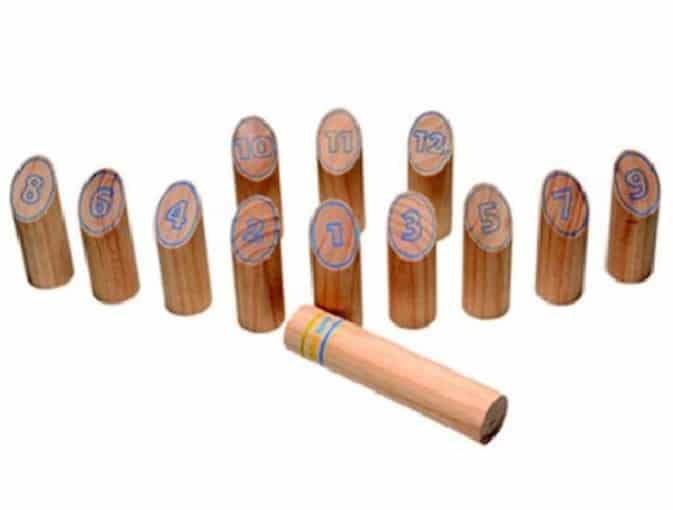
Many reviewers also hadn't heard of Molkky before ordering it, but were pleasantly surprised by how much fun the game is.
“Easy to set up, simple rules, a lot of challenging others, it all makes for fun moments for our family,” wrote one reviewer.
The simple rules make this a hit with all ages, as many reviewers point out, and large groups.
“Nice for any number of players (as opposed to Bocce or tossing beanbags, where you're limited to 2 or 4),” writes one reviewer, adding that it
"Is good for kids because they can throw a little closer, and more importantly, if they get bored and want to quit it doesn't stop for everyone."
One user likened the game to "combining the best elements of horseshoes, bocce, with the hand-eye coordination of bean bags," but many simply describe it as similar to bowling.
A general warning about the game is that it is best suited for the grass.
"You do need a flat garden with shorter grass to get the pegs upright," writes one reviewer.
Another says: "We were playing on asphalt one day and it damaged the pins a bit."
As long as you do the necessary prep work, you'll hopefully find that “It's still slow enough to have a beer and chat with your friends while you play, which is really the main reason for many to get a lawn game. ”
Best for smaller children: ring throwing dancing worm
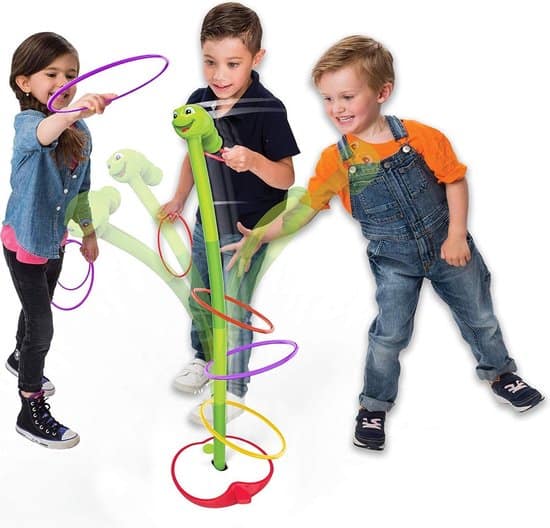
This game is much safer than the original which comes with iron horseshoes and an iron base, ”says one reviewer. But it is essentially the old horseshoe throwing of the past.
That is why so many users have bought this ring set specially made for children from 3 years old for children.
“My family plays ring throws quite often in the summer,” wrote one reviewer.
“We have a set for adults and the kids always want to play. The horseshoes are just too heavy for them. I bought this set so my kids could play too. They love it. ”
Best Yahtzee Outdoor Game: BS Toys
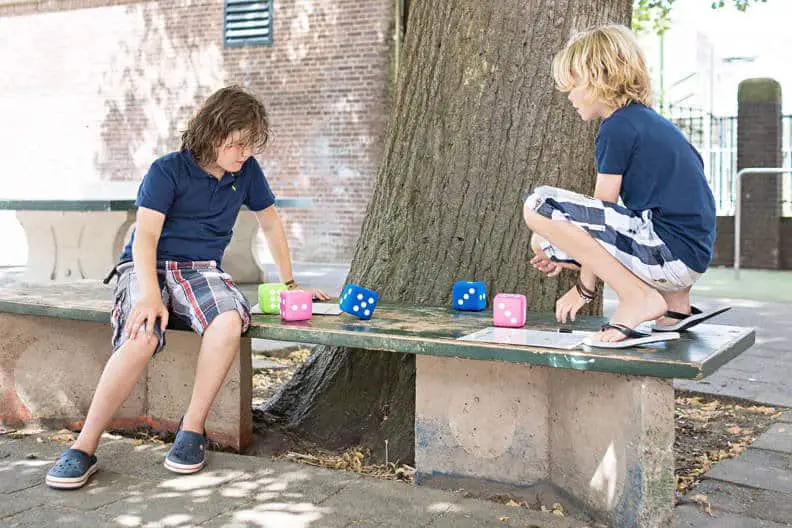
One reviewer saw this set of giant dice "at a graduation party this summer and ordered it literally right after the party."
In addition to graduation parties, reviewers love this one for family vacations and barbecues.
“We are big Yahtzee fans and bought this game for a family BBQ,” writes one reviewer.
“Everyone loved it and had a great time playing outside. The dice are the perfect size, great quality and loved the scoreboard. ”
Another comment is that this set is “better than I expected”.
“They are big and well made, but not too heavy to carry or use,” writes one user.
"They are soft and the corners are all rounded and the sides are smooth."
Many players also grab a bucket of me when buying this game to "get the real Yahtzee feel" as one user put it.
Best for the two of you: four in a row great for outside
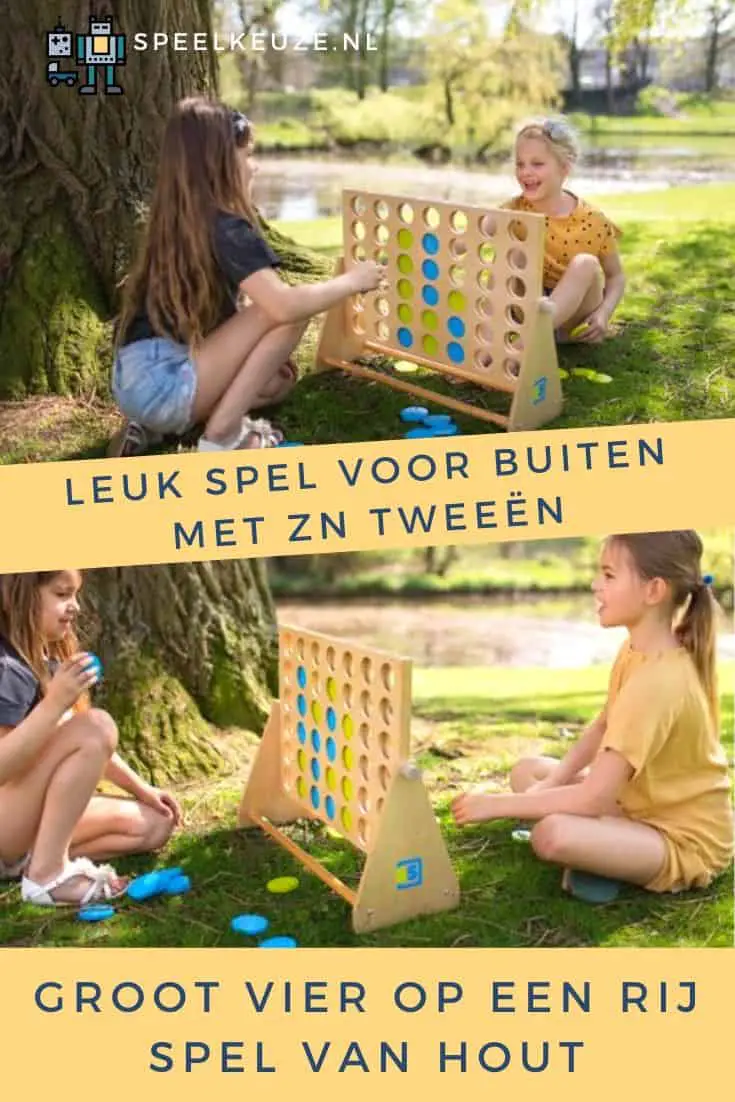
Reviewers rave about how beautiful this BS Toys set looks, which is probably why many users like it well enough to use during special occasions.
"The pellets are smooth and the wood is beautiful." Another says it is "almost too good to use outside".
Also, this newlywed says, “It was also a BIG hit as one of the games at our wedding.””
"Only bad thing I have is the sound of the falling pucks because that means we can't play after the little one is in bed because we would probably wake her up, but that's a minor drawback to say the least."
Best Garden Jenga: Giantville Tumbling Timber
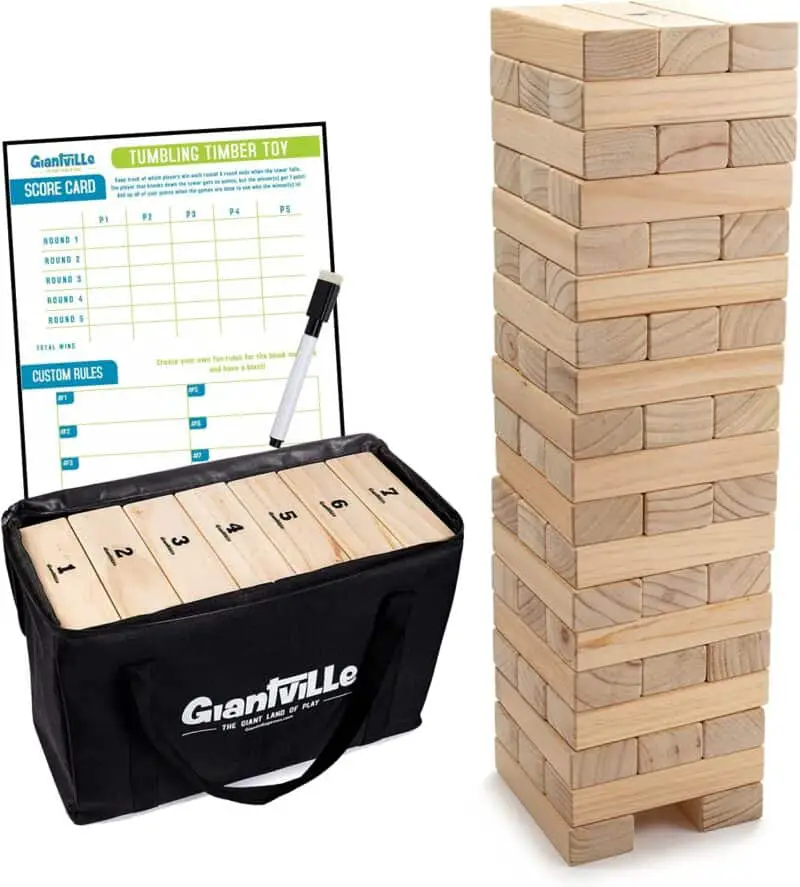
Reviewers are very impressed with how durable this Jenga set is. “I have a party rental business and my big Jenga games go out almost every weekend,” writes one reviewer.
Another reviewer said the blocks "can handle the throwing and carelessness of young children."
On the other hand, one reviewer warns that because the blocks themselves are so strong, everything else is at risk.
This user recommends placing them on a surface that is “resistant to the dents and scratches” associated with this game tipping over.
One reviewer, calling this game a “go-to” for their family, says, “We've had groups of family and friends of up to ten players. Everyone has a lot of fun and gets very involved in the game. … If you are considering buying this set, go ahead and make the purchase, you will be happy with your decision! ”
Can Jam Ultimate Disc Game

“If you don't play Kan Jam, you don't know what you're missing,” says one reviewer, who may sound harsh, but sums up how much fun reviewers think this game is.
“This is a ridiculously fun and easy lawn game,” wrote another reviewer.
“It has the strategy of horseshoes with the pleasure of a team activity. The rules are simple, the gear is built to last - if you're looking for a semi-active game to take to the beach, a family BBQ or even a corporate picnic, this is it! ”
Many reviewers mention how this game engaged their entire family and even inspired annual tournaments.
“It's a team game that's so much fun to involve the whole family,” writes one reviewer.
Another says it, “really helps to create community-friendly and friendly competition.
Check the most current prices at bol.com
Best boules set: Get & Go
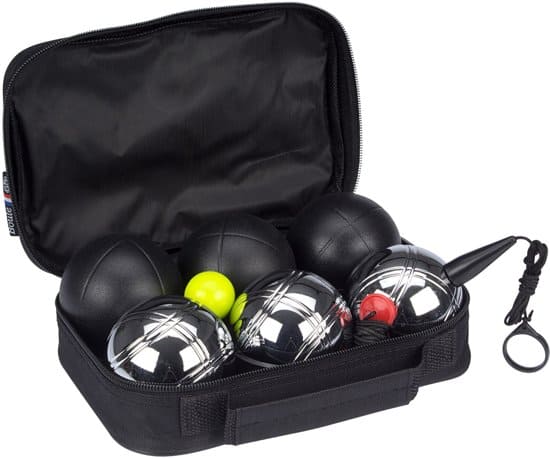
Many reviewers state that these bocce balls may not be official size, but there are plenty of beginners out there who play for fun and are fine with them.
"I don't know if they are tournament size, but I don't play in tournaments other than the one my 7-year-old boy orchestrates in the yard," writes one reviewer.
For their purposes “the balls are quite large. The markings are easy to identify. And the quality is generally great for the price. ”
Like this reviewer, many state that this is a great price for a bowling set. “I've paid a lot more for a set that doesn't match this,” writes a more experienced player, “as much as € 100 for a“ traditional set ”in my past.
But these come in a light bag and are easy to store, carry and the balls are great in the hand. Even traditionalists will love the feel and touch of playing a game of this. ”
Best outdoor game for the pool: Atomic vortex
How To Play:
- Tell the kids to get in the pool and line up around the edge of the pool (in the pool, because we don't want accidents of course!)
- First, tell the children to walk around the edge of the pool
- After about 30 seconds of walking, have them jog around the edge of the pool now
- Have them start running after about 30 seconds of jogging. At this point there should be a strong current pulling them along.
- Tell the players to stop and walk in the other direction. It's almost impossible to move against the current!
Tip:: The more children you have, the stronger the vortex. This is one of the best board games for the pool so everyone at the campsite can participate!
Jumping on the trampoline
Trampoline jumping is always a good activity for children. It is good for their condition, blood circulation and it also helps them burn off their energy. But if they've been on it too many times it might lose a bit of its shine. Then choose a trampoline game to breathe new life into the jumping mat.
One of the best trampoline games is who am I. Depicting something while jumping is not very easy!
Still, you should make an effort to convey to your friends, in as few jumps as possible, what you mean.
The one with the least number of jumps wins in this game!
It is wise to agree on a theme, otherwise guessing can take a very long time…
Skateboarding
Skateboarding is a sport where you stand on a board (deck) with wheels underneath. You have to stand on it while moving or performing tricks.
A fun activity with skateboarding is practicing and performing tricks, such as ollies, kickflips and grinds. This gives skateboarders the chance to show their skills and creativity while using obstacles and ramps for extra challenge. It's an exciting way to improve skateboarding skills and have fun.
Beach volleyball
If you are going to the beach for a nice day, beach volleyball is a great option. It is one of the best games for the beach and everyone can participate. All you need is a beach ball (lightweight and easy to bounce on soft sand) or a real volleyball for older kids. A net with associated poles is also nice but not necessary (and often available on public beaches).
You can hit each other back and forth and keep the ball in the air for as long as possible, or for some competition you divide the players into two teams. Normally a beach volleyball team consists of two players on each side, but you can adjust the size of the teams depending on the number of players you have.
Why do children play outside less?
The numbers don't lie: Children play outside much less than previous generations.
Indoor play is popular. This is mainly due to the addictive digital devices. The digital world is attractive to children. Professor Peter Nikken, senior advisor on youth, media and media education at the Netherlands Youth Institute and professor of Youth and Media at Windesheim University of Applied Sciences, says that the time children spend on devices has grown in recent years.
“It's like finger painting for them. You don't need more than a fingertip. You touch it and something happens on its own, ”says Professor Nikken.
But this also makes it more difficult to stop, Professor Nikken explains. “Because it is so easy for children, they no longer have any inhibitions and they keep going.
What do children think of playing outside?
So those tablets are very interesting. But what do children think of playing outside? Isn't that fun at all anymore? Well, that's not entirely true. Although the figures do reveal a critical note. For example, in the research by Jantje Beton and Kantar (2018) we see that:
- 39% of the children prefer to play indoors;
- Three quarters of the children indicate that there should be more exciting play areas (74%);
- According to 58% more activities should be organized;
- And according to 57% there should be more squares or lawns.
The result? Fewer children play outside. This makes it difficult to play together and make new friends. Too bad, because playing outside is so healthy!
What are the benefits of playing outside?
Sitting indoors all day is not healthy for anyone, but especially not for children. They are in full development, and sitting indoors a lot can be harmful.
The following factors of outdoor play are extremely important for the development of children:
Healthy Eyes
We now know that watching a lot of television, but also reading a lot, for example, has no positive effect on our eyes.
This has to do with the distance from the eyes to the screen.
Children who look at a screen too much run the risk of myopia, which means that they need glasses early.
By going outside a lot, you ensure that your child also has to view things from a great distance.
In this way, the muscles in the eyes develop better. And that is important at a young age, in the period when the eyes are developing.
Outdoor Movement
Perhaps obvious, but outside there is more space, so a child will move more quickly while playing outside than playing inside.
Running, jumping, climbing: It's all good for fitness, motor development, spatial awareness, and the development of muscles and bones.
In addition, actively playing outside ensures a healthy immune system, a good dose of vitamin D, and reduces the risk of cardiovascular disease and obesity.
Creativity
The outside environment is cognitively stimulating for children. Creative, new games are conceived and executed here.
Turning the playground into a jungle, collecting and trading stones as if they were valuable diamonds, or having temporary super powers ...
Playing outside stimulates children's imaginations.
Play together
A child can play indoors well alone. Hours can be filled with games or YouTube videos.
Playing outside, on the other hand, encourages playing together with other children. This has a positive effect on the development of social skills and empathy.
For example, losing or winning a game of football. Or negotiate to make sure you get to play on the best team.
In short, the list is long. Perhaps the most important thing is that 75% of the children indicate that they feel cheerful and happy after playing outside for a while (Kantar & Jantje Beton 2018).
An extra reason to encourage children to go outside more!
How do you encourage children to play outside?
But, how do you get children to resist the addictive screens and go outside? We asked a number of experts for tips.
“We recommend that parents encourage children to exercise for one to one and a half hours every day, especially playing outside.” – Anja Oude Lansink, JGZ Staff Nurse at GGD Kennemerland.
The GGD supports families and children whose health is at risk, partly due to too little exercise.
We then look together at drawing up rules.
For example, consider a maximum of two hours of screen time per day, or unlimited screen time one day a week during the holidays.
When drawing up these rules, it is important to consider what suits a family. “We are not going to point the finger at 'this is how it should be', but we do give suggestions and indicate what other parents are doing, for example,” says Anja Oude Lansink.
According to Anja, it is important as a parent to think carefully about media education and setting boundaries.
"Two-year-olds are already regularly on a tablet or something similar, so it actually starts with thinking about as early as possible as a parent of gosh, what do I really want with regard to media education, and how do I deal with that?"
However, the GGD is not against apps and screens. For example, the Runkeeper app can provide useful insight into calorie consumption, and certain games on the Wii can provide a good workout.
Anja also gives the tip to look at what there is to do in the area for children.
It is important that the activities are close to home, so that the threshold is much lower to participate.
“Go outside yourself. But it doesn't always have to be together. Let children go on adventures themselves, because they really enjoy that. It's just part of a healthy upbringing. Just as you pay attention to healthy eating, also make sure that children enjoy going outside.” -Pauline van der Loo, team leader programs at Jantje Beton
Jantje Beton is the charity that, together with children, strives for more space and playing time.
Every year, more than 350.000 children participate in Jantje Beton's activities and projects.
Jantje Beton, for example, organizes an annual NK Curbs and, in collaboration with Nickelodeon, the National Outdoor Play Day.
Their motto is: Never stop playing.
Why is the outdoor play environment so important for encouraging outdoor play?
The play environment is very important for the extent to which children want to play outside. In 2018, Jantje Beton conducted research into outdoor play in collaboration with Kantar Public. Pauline van der Loo says:
"Children themselves indicate that there are too few other children outside, that they prefer to play inside, and that they find it boring outside."
How can children find playing outside boring? “Children think it is important that there are more mysterious places and that they can play more adventurously.
It is not always about playground equipment, but especially about one play environment with space and more adventurous places,” says Pauline.
Jantje Beton is therefore working with children to look at how the neighborhood can be made more playful so that more children go outside.
And what can parents do to encourage outdoor play? “Set a good example, very important of course!
But sometimes it is also a step to go outside, it can be exciting.
You can also go through the neighborhood with your child, for example. Where do children you might know live? Where can you play nice here?
That you will explore that together. Another tip could be that you, for example, create an app group with parents in the neighborhood of: When will they play outside?
Or you agree that you will always play a game with each other in the evening after dinner. ”
And of course children can participate in the activities organized by Jantje Beton, or ask them for help in making the neighborhood more playful.
“Children themselves also indicate that they spend too much time on devices. But the temptation is too great. ” - Maarten Wolzak, co-founder of Myndr
Myndr: The thermostat for your internet. With a simple button on the wall you can easily filter internet services. The consequence? More attention for your family.
Maarten Wolzak, co-founder of Myndr, says that the idea originated during a dinner with friends where the children were constantly distracted by their mobile phone.
“We had a conversation with those parents about how they had so much trouble with that, and that it was so terribly annoying in the relationship between the children and the parents.
On the way back from that, my wife said: 'You are always working on extra projects, can't you do something about it?' ”
But, Maarten emphasizes, Myndr is not only developed for children. Screens are everywhere and equally addictive for everyone.
Adults, and even the elderly, are also addicted to the devices.
“You see it with everyone. You regularly walk down the street and you see terraces where two seniors have a drink next to each other and they are both on their phones.
Or in a restaurant you see a whole family behind the mobile phone while they are out for dinner together. Take the train once: Everyone is on it. ”
Myndr works as a digital yes / no sticker. It consists of two parts: The Myndr switch and the Myndr WiFi.
A cable that you connect to the router acts as a doorman and ensures that certain websites and notifications do not arrive.
A button on the wall determines the 'door policy': Which websites and notifications do you allow at that time? Handy, for example, for when children are doing their homework.
Wikipedia can still be visited, but Facebook and Instagram cannot. So less distraction.
In this way, Myndr is a tool to better use the internet.
In addition, the button on the wall makes the whole process democratic. Every member of the family can see the switch and turn it.
And that is important, says Maarten. Children are well aware that they spend too much time on devices.
But the temptation is great. “So we don't think it makes much sense to ban things.
That's why Myndr is meant to be a democratic process, just like you may or may not turn on the television during dinner.
You also determine that together.
Sometimes it is, for example when there is an important match or something else, and the other times not because you want to talk to each other. ”
The result is that children also regularly turn the switch as soon as their parents are too busy with devices.
Isn't that boring without the internet? “Sometimes yes,” says Maarten.
But, he says, boredom is not a bad thing. It has long been part of a child's daily activities.
It stimulates children to become creative and to look for alternatives themselves. Like playing outside!
Expert 4: Picoo- Playing outside with Technology
“How do you get children off the couch? That is the basis with which we started Picoo. ” - Daniel Tetteroo, Co-Founder Picoo.
Together with his partner Iris Soute, Daniel Tetteroo invented Picoo.
This portable game console combines interactive technology with traditional outdoor games. Ideal to take outside.
Iris and Daniel raised the question: How do you ensure that children go outside more, and especially enjoy it?
“You can basically pull your child off the couch, push out the door and say, 'Well, enjoy yourself.'
But then you force play outside and a child is not motivated to go outside by itself.
So we thought: Can't we do that in a fun way so that children want to play outside?
And what do they like about playing indoors? That's that interactive of games. Can't we take that element outside with us? "
You will receive Picoo in a set of 12. All kinds of games can be played by means of light, sound and vibrations.
Think of tag, hide and seek and the exciting self-made spy hunt.
You get five games, but new games can be added via an accompanying app.
The basis of Picoo is playing fun games, to which an educational element can be added later.
The sensors in the Picoos measure movement and sound, among other things, and respond to this.
The Picoos also see if there are other active Picoos in the area so that it is easy to play together.
Because Picoo works with its own radio network, no internet connection is required. Picoo can therefore be taken to the playground, the forest, the beach ...
It works everywhere.
The big advantage of Picoo is that there is no screen on the device.
“A child's attention is therefore not always drawn by the screen where all kinds of things are happening, but at first the attention is mainly drawn by the other players who are in the game,” says Daniel.
This means children are less concerned with technology and more concerned with each other. And that is positive for the social development.
Not only children like Picoo to play with. Daniel explains:
Our target group is children from 6 to 12. Children from the age of 4 can sometimes also play. But very honestly; Children over 12 and adults also really enjoy it! ”
The reactions have therefore been very positive so far. After a while of playing it is even difficult to get the Picoos back and you are asked: "Can I go again?"
Picoo is currently available for schools and companies <. The goal is to develop a version for home next year.
"I wanted to use the enemy, in this case the technology of today, as a friend to encourage children to play outside again." - Teun Latour, student of Business Studies at the Hogeschool van Amsterdam and co-founder of the app Pleintje.
The idea started with a walk with his parents through his old neighborhood.
Business Administration student Teun Latour immediately noticed that the schoolyard where he used to play was completely deserted.
“There was no child to be seen, you only heard the wind blowing through the trees,” says Teun.
“It was really a reality check of: what's going on? Why don't the children of today enjoy playing outside so much anymore? ”
A minor during his studies offered him the opportunity to further develop the idea together with his partner and fellow student Mik Remmers.
The assignment was to start up your own company.
Teun and Mik immediately wanted to make an app for children. Student Sadjad Mohammadi, Communication and Media Design student, joined them.
It was not easy at first. Teachers were hesitant about the idea of creating an app because of previous experiences.
“It was quite rejected by some teachers in the beginning. But we were pretty tough. We thought yes, sorry, but we will just do this. We support this and want to do this at all costs. ”
After thorough preliminary research with a marketing agency, they were convinced: There should be an app that encourages children to play outside.
The result is Pleintje. The app offers children the opportunity to play interactive outdoor games together.
Children can invite each other through the app. Then they choose a play area and a play category.
“And these are games with a football, outdoor games such as tag, hide and seek and Annemaria Koekkoek, up to games with toys or play equipment such as jumping rope, skateboarding and you name it.”
What makes the app special are the coins that are handed out to the players after playing. This allows them to personalize their personal avatar.
This one gets more beautiful and cooler with time.
And it is not about one avatar, but each game category has its own figure. This is in line with current trends in children's toys.
"Pokémon used to have that too, of course. Your Pokémon is getting better and better and cooler, we now want to bring that to the child by moving more and playing together."
Pleintje also keeps an eye on the wishes of parents. This way parents can see where their children are. That gives a safe feeling.
If a child finds himself outside the agreed area, parents will receive a notification or a pop-up, with the option to call or send a message to the child. Ideal!
At the moment Teun, Mik and Sadjad are working hard to develop the app.
The app will be free for children, but if you as a parent want to keep an eye on your child, you will pay a meager two euros per month.
A telephone is necessary, preferably with internet, although an offline version will also appear on the market.
If you can't wait until the Pleintje app becomes available in the app store, there are a number of alternative apps on the market that encourage outdoor play and can be downloaded for free.
Geocaching
Does your child love treasure hunts? Then Geocaching is recommended. With Geocaching you go outside in search of hidden treasures (Geocaches) via GPS.
The app will lead you to the location of the Geochache, and then the search is over. Did you find the treasure?
Then write in the logbook, trade one of the items, and look for the next!
Troovie
You can get started creating treasure hunts yourself with the Troovie app.
You go on a treasure hunt in your neighborhood, where you choose from different adventures and ready-made or self-invented assignments.
The app is free, but if you want to go out longer and have more choice in ready-made assignments, there is a paid version. Troovie is also a lot of fun to use for children's parties.
Rootsj
Roootsj provides insight into the playgrounds in your area.
By means of tips from other parents you can see which playgrounds are located in the area and how they are rated.
Ideal for taking the children to a playground that is new to them on a free Saturday or Sunday.
Do you know some nice places yourself? Then add it to the app, so that other parents and children can also enjoy the most beautiful places in the neighborhood.
wokamon
Do you remember the Tamagotchi? This virtual pet was extremely popular in the late 90's. Wokamon works almost the same as the Tamagotchi.
Here too you can choose from different animals and watch them grow up.
The difference? To make the Wokamon grow, you have to move and walk. The downside to this app is that Wokamon is only available in English.
And if the weather is really bad ...
Tips from Expert 6: Professor Peter Nikken
Despite all the above tips, some cold, wet winter days are simply not suitable for playing outside.
And, to be fair, playing on a tablet or phone is also a lot of fun. How do you play wisely on digital devices?
Try to ensure that the time on devices is well spent, says Professor Nikken.
For example, offer educational apps and review them critically before downloading them.
Is the content appropriate for the age of the children and is the information disseminated by the app correct?
“That is quite difficult for parents to figure out,” says Professor Nikken.
Often, app builders claim that their app is age-appropriate and contains educational content.
But often these types of apps have not been tested enough, so the question is whether this is actually the case.
How do you know whether an app is really suitable?
First, take a good look at the description of the apps, that is a first impression. Read more online reviews and ask about the experiences of other parents.
“Or the children's library,” says Professor Nikken. “Ask the children's librarian if he or she has advice. Nowadays they are increasingly developed in this area. ”In this way you can ensure that if your child looks at a screen, it is not harmful and maybe even educational.
“It doesn't necessarily have to be all bad,” continues Professor Nikken.
"But it depends on the balance between screen use and being outside."
When are outdoor games the most fun to do with the family?
To make outdoor family games a success, it's important to keep some considerations in mind:
- Choose suitable games: Select games that are appropriate for the ages and interests of all family members. Make sure the games are not too complicated and that everyone can have fun.
- Weather and timing: Take the weather and timing into account. For example, choose a sunny day for activities such as picnics, badminton or cycling. If it rains, consider planning activities indoors.
- Safety first: Make sure the games and activities are safe. Use protective equipment if necessary, such as bicycle helmets or sunscreen. Also consider possible allergies or health problems.
- Involve everyone: Encourage participation by involving everyone in choosing the games and activities. Everyone's input makes it more fun for all family members.
- Avoid competition: While some friendly competition can be fun, the goal of outdoor games should primarily be fun and togetherness. Avoid too much emphasis on winning and losing.
- Variation: Alternate the games to avoid boredom. Try to incorporate both active games and more relaxed activities, such as kite flying.
- Picnic and snacks: Bring some treats for a picnic or snacks to enjoy while playing. It can maintain energy levels and provide extra comfort.
- Leave room for free time: In addition to planned games, it is important to make time for free play and relaxation. Children often enjoy having their own adventures.
- Flexibility: Be flexible in your planning. Sometimes the weather changes or people need some rest. Adjust your plans accordingly.
- Enjoy the moment: The most important thing is to enjoy being together and the outdoors. Put your phone away and focus on time spent with your family.
This takes care of the best games for home, in the garden or in nature and you can ensure that outdoor games with the family are fun and successful, with everyone creating beautiful memories.
How can toys help get children outside?
The right outdoor toys can encourage children to get fresh air, embrace physical activity, express their creativity and explore nature. It is important to choose outdoor toys that suits the child's interests and motivates them to be active and enjoy outdoor activities.

Always something to do for the holidays or rainy day?
Play Choice now has the ultimate activity book collection, with over 60 pages of fun coloring pages and educational puzzles.
Joost Nusselder, the founder of Speelkeuze.nl is a content marketer, father and loves trying out new toys. As a child he came into contact with everything related to games when his mother started the Tinnen Soldaat in Ede. Now he and his team create helpful blog articles to help loyal readers with fun play ideas.